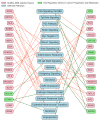Identifying Key Genes Involved in Axillary Lymph Node Metastasis in Breast Cancer Using Advanced RNA-Seq Analysis: A Methodological Approach with GLMQL and MAS
- PMID: 39000413
- PMCID: PMC11242629
- DOI: 10.3390/ijms25137306
Identifying Key Genes Involved in Axillary Lymph Node Metastasis in Breast Cancer Using Advanced RNA-Seq Analysis: A Methodological Approach with GLMQL and MAS
Abstract
Our study aims to address the methodological challenges frequently encountered in RNA-Seq data analysis within cancer studies. Specifically, it enhances the identification of key genes involved in axillary lymph node metastasis (ALNM) in breast cancer. We employ Generalized Linear Models with Quasi-Likelihood (GLMQLs) to manage the inherently discrete and overdispersed nature of RNA-Seq data, marking a significant improvement over conventional methods such as the t-test, which assumes a normal distribution and equal variances across samples. We utilize the Trimmed Mean of M-values (TMMs) method for normalization to address library-specific compositional differences effectively. Our study focuses on a distinct cohort of 104 untreated patients from the TCGA Breast Invasive Carcinoma (BRCA) dataset to maintain an untainted genetic profile, thereby providing more accurate insights into the genetic underpinnings of lymph node metastasis. This strategic selection paves the way for developing early intervention strategies and targeted therapies. Our analysis is exclusively dedicated to protein-coding genes, enriched by the Magnitude Altitude Scoring (MAS) system, which rigorously identifies key genes that could serve as predictors in developing an ALNM predictive model. Our novel approach has pinpointed several genes significantly linked to ALNM in breast cancer, offering vital insights into the molecular dynamics of cancer development and metastasis. These genes, including ERBB2, CCNA1, FOXC2, LEFTY2, VTN, ACKR3, and PTGS2, are involved in key processes like apoptosis, epithelial-mesenchymal transition, angiogenesis, response to hypoxia, and KRAS signaling pathways, which are crucial for tumor virulence and the spread of metastases. Moreover, the approach has also emphasized the importance of the small proline-rich protein family (SPRR), including SPRR2B, SPRR2E, and SPRR2D, recognized for their significant involvement in cancer-related pathways and their potential as therapeutic targets. Important transcripts such as H3C10, H1-2, PADI4, and others have been highlighted as critical in modulating the chromatin structure and gene expression, fundamental for the progression and spread of cancer.
Keywords: RNA sequencing (RNA-Seq); axillary lymph node metastasis (ALNM); breast cancer; gene expression analysis; generalized linear models; quasi-likelihood F test.
Conflict of interest statement
The authors declare no conflict of interest.
Figures












Similar articles
-
Development and validation of a pre- and intra-operative scoring system that distinguishes between non-advanced and advanced axillary lymph node metastasis in breast cancer with positive sentinel lymph nodes: a retrospective study.World J Surg Oncol. 2022 Sep 28;20(1):314. doi: 10.1186/s12957-022-02779-9. World J Surg Oncol. 2022. PMID: 36171615 Free PMC article.
-
Predictive factors associated with axillary lymph node metastases in T1a and T1b breast carcinomas: analysis in more than 900 patients.J Am Coll Surg. 2000 Jul;191(1):1-6; discussion 6-8. doi: 10.1016/s1072-7515(00)00310-0. J Am Coll Surg. 2000. PMID: 10898177
-
Added Value of MRI for Invasive Breast Cancer including the Entire Axilla for Evaluation of High-Level or Advanced Axillary Lymph Node Metastasis in the Post-ACOSOG Z0011 Trial Era.Radiology. 2021 Jul;300(1):46-54. doi: 10.1148/radiol.2021202683. Epub 2021 Apr 27. Radiology. 2021. PMID: 33904772
-
Early-stage invasive ductal carcinoma: Association of tumor apparent diffusion coefficient values with axillary lymph node metastasis.Eur J Radiol. 2015 Nov;84(11):2137-43. doi: 10.1016/j.ejrad.2015.08.009. Epub 2015 Aug 20. Eur J Radiol. 2015. PMID: 26318821 Review.
-
Sentinel lymph node as a new marker for therapeutic planning in breast cancer patients.J Surg Oncol. 2004 Mar;85(3):102-11. doi: 10.1002/jso.20022. J Surg Oncol. 2004. PMID: 14991881 Review.
Cited by
-
Tracing the evolutionary pathway of SARS-CoV-2 through RNA sequencing analysis.Sci Rep. 2025 Jul 4;15(1):23961. doi: 10.1038/s41598-025-09911-1. Sci Rep. 2025. PMID: 40615624 Free PMC article.
-
Assessing concordance between RNA-Seq and NanoString technologies in Ebola-infected nonhuman primates using machine learning.BMC Genomics. 2025 Apr 10;26(1):358. doi: 10.1186/s12864-025-11553-6. BMC Genomics. 2025. PMID: 40211167 Free PMC article.
-
Machine Learning Analysis of RNA-Seq Data Identifies Key Gene Signatures and Pathways in Mpox Virus-Induced Gastrointestinal Complications Using Colon Organoid Models.Int J Mol Sci. 2024 Oct 17;25(20):11142. doi: 10.3390/ijms252011142. Int J Mol Sci. 2024. PMID: 39456924 Free PMC article.
References
-
- Negoita S., Chen H.S., Sanchez P.V., Sherman R.L., Henley S.J., Siegel R.L., Sung H., Scott S., Benard V.B., Kohler B.A., et al. Annual Report to the Nation on the Status of Cancer, part 2: Early assessment of the COVID-19 pandemic’s impact on cancer diagnosis. Cancer. 2024;130:117–127. doi: 10.1002/cncr.35026. - DOI - PMC - PubMed
-
- Cancer Stat Facts: Female Breast Cancer. [(accessed on 10 January 2024)]; Available online: https://seer.cancer.gov/statfacts/html/breast.html.
-
- American Cancer Society. [(accessed on 10 January 2024)]. Available online: https://www.cancer.org/research/cancer-facts-statistics/all-cancer-facts....
MeSH terms
Substances
Grants and funding
LinkOut - more resources
Full Text Sources
Medical
Research Materials
Miscellaneous

